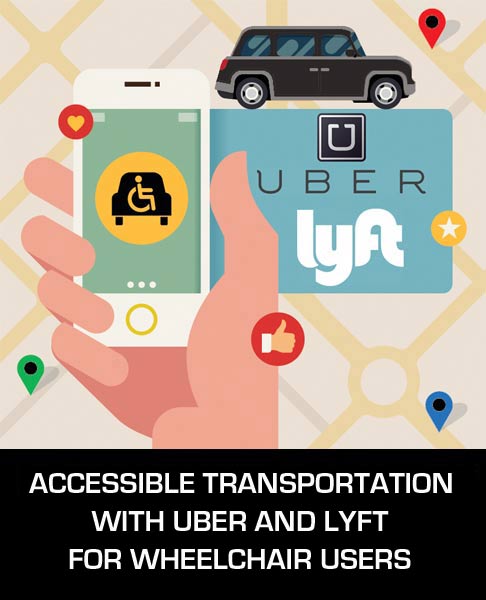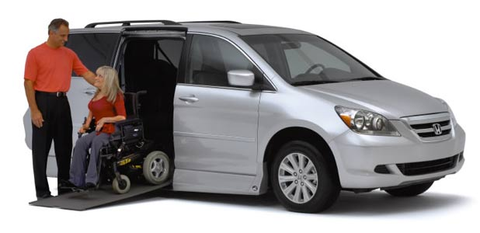
The popular ride sharing services from Uber and Lyft are making wheelchair accessible transportation more convenient for many individuals using phone apps. If you don’t know what Uber or Lyft is, chances are you have heard the words mentioned in brief conversations. These two vehicle-for-hire companies are becoming increasingly popular due to offering convenient and affordable transportation to consumers in certain areas in the USA and soon internationally. What exactly do these companies do and are they wheelchair accessible?
How to use these services
To use these on-demand accessible transportation services, wheelchair users and individuals with disabilities and their care takers need to download and install Uber or Lyft apps for their smartphones. Once installed and linking a payment method with a credit card, individuals can request transportation when needed simply with a tap of their phone. Choose a vehicle type, mark your pickup location on the map and enter your destination drop off and wait for your ride. Your card will be debited using your phone at the end of your drop off destination. The payment is processed through the credit card linked to the consumer’s profile on Uber or Lyft apps.
Uber

Uber has taken steps to offer wheelchair accessible transportation to consumers with UberWAV and UberACCESS. Transportation can be requested at the tap of a button on their convenient app. Types of wheelchair accessible vehicles include Dodge Grand Caravan, Honda Odyssey, Ford Transit Connect, Ford E-150/250, Mercedes Sprinter, Ford E-250-Extended and the Ford E Minibus. Uber refers to their specialized wheelchair accessible options as UberWAV and UberASSIST, which is specifically meant for riders in wheelchairs and their companions. At the time of this publication, UberWAV options are only available in the New York City area and UberACCESS is available in Houston. Uber is in the process of increasing the number of states and cities they offer wheelchair bound consumers the opportunity to use the service. Check with Uber directly for updated information.
Lyft

Lyft offers passengers who have wheelchair accessibility needs to use their Accessible Vehicle Dispatch services via their app. They provide a list of paratransit taxi services that they work with to offer specially outfitted vehicles to accommodate wheelchair users. The accessible transportation must be booked at least 24 hours in advance. Consumers are encouraged to reach out to the local accessible vehicle dispatch to go through the sign up process since it can take up to several weeks to complete the enrollment process with the vendor. At the time of this publication Lyft offers wheelchair accessible vehicles in the following areas.
- Arizona: Pheonix and Tuscon
- California: Inland Empire, Fresno, Bakersfield, Los Angeles, Modesto, Napa and Sonoma County, Orange County, Sacramento, San Diego, San Francisco, Easy Bay, Santa Barbara, South Bay and Stockton.
- Colorado: Denver and Colorado Springs.
- District of Columbia: Washington, D.C.
- Florida: Jacksonville, Miami, Orlando and Tampa.
- Georgia: Atlanta
- Hawaii: Honolulu
- Illinois: Chicago
- Indiana: Indianapolis
- Kentucky: Lexington and Louisville
- Maryland: Baltimore
- Massachusetts: Boston
- Michigan: Ann Arbor and Detroit
- Minnesota: Minneapolis/St. Paul
- Nebraska: Lincoln and Omaha
- New Jersey: Northern New Jersey Area
- New York: New York City
- North Carolina: Charlotte, Raleigh-Durham
- Ohio: Cincinnati, Cleveland, Toledo,
- Oklahoma: Oklahoma City and Tulsa
- Oregon: Portland
- Pennsylvania: Pittsburgh and Philadelphia
- Rhode Island: Providence
- Tennessee: Nashville
- Texas: Austin, Corpus Christi, Dallas Fort Worth and San Antonio.
- Utah: Salt Lake City
- Virginia: Virginia Beach
- Washington: Seattle and Spokane
- Wisconsin: Madison and Milwaukee
Future of On-Demand Accessible Transportation Services
While Uber and Lyft type companies may be battling with the taxi cab industry, the future looks bright. The business model used to create these services is impressive to many companies worldwide. By the end of 2014, Uber alone had 160,000 drivers regularly working within the United States, with about 40,000 new drivers that had signed up during the month of December. The business is growing at a rapid pace with sign-ups doubling about every six months.
Current Lawsuits
As with any new start-up business, it has to experience growing pains. Uber and Lyft are especially feeling the pain when it comes to current lawsuits. Both companies are currently being sued for allegedly denying service to passengers that had a guide dog and passengers who are wheelchair users. There are two defendants in Texas and California that are alleging the services violated the Americans with Disability Act (ADA) by not making wheelchair accessible transportation available. The ADA requires vehicles-for-hire to offer reasonable accommodations for wheelchair users. In Boston, legislature is considering a proposal by Governor Charlie Baker to regulate vehicle-for-hire services. On a separate case, the Department of Justice released a filing saying the vehicle-for-hire companies “may not contract away its ADA responsibilities” and the laws set in the ADA “applies to private entities that are primarily engaged in providing transportation services”. The current law suits are pending until it is settled whether the companies are merely a software company connecting consumers with a transportation service or otherwise.
Safety Ride Checklist

Whichever option consumers choose for their vehicle-for-hire services safety is always first priority. While the companies take measures to screen their drivers, there is always a possibility of error. To assure passengers are getting in the car with a safe driver, consumers should always check the following.
- Confirm the license plate listed on the app is the same as the car
- Confirm the name and picture on the app matches the driver in the car
Although there are pending court cases against Uber and Lyft, there are signs that both companies are making changes to accommodate disabled passengers and wheelchair users. While it may take time to fully have the companies adhere to the laws in the Americans with Disability Act, the wheelchair accessible services are catering to wheelchair customers on a daily basis. The choice to use the services from Uber and Lyft is always in the hands of the consumer and depends on the comfort level of the wheelchair passengers.
